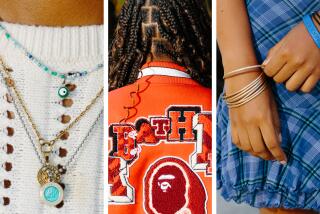Casual Comes Out of the Closet : But as IBM, Others Scrap the Suit, Some Say It’s a <i> Faux Pas</i>
- Share via
In the business world of the ‘90s, the man in the gray flannel suit might be wearing a blue polo shirt and khaki trousers.
The dress code at many firms has loosened up over the years in a reflection of changing corporate cultures. On Friday, International Business Machines--where once everyone from the chairman to repairman wore look-alike suits--went casual, too.
But some experts in corporate couture say IBM’s switch is a fashion faux pas . John T. Molloy, author of the business fashion bible “Dress for Success,” said that casual work wear has many drawbacks and that the uniform dress and look of the IBM employee served a purpose.
“Part of the perception that gave them an edge was that corporate dress code,” Molloy said. “It said, ‘We are step above.
We are different. We are not like the other guys.’ What IBM has done is a colossal blunder.”
Despite potential drawbacks, IBM employees will now be able to dress down at work after Chairman Louis V. Gerstner Jr. let it be known through word-of-mouth that the unofficial IBM dress code that influenced the way Corporate America dressed for decades was no longer in effect.
It’s part of a massive reorganization aimed at tearing down the computer giant’s bureaucratic culture and replacing it with a more energetic and competitive environment. The computer company also on Friday announced that it will move to a new, more intimate and casual headquarters building in a campus-like setting.
“This is really just giving employees a choice,” said spokesman Scott Brooks of the liberalized dress code. “There are no rules. We are not saying you can wear this or this. If they have a big customer meeting, they would tend to wear a suit. If they will work on a project in front of a PC all day, they will dress more casually.”
But habits are hard to change. On the first day of IBM’s new fashion policy, Brooks wore a gray suit.
IBM has joined a long and growing list of major corporations that allow people to do without suits on designated “casual days”--or for the entire week. General Motors, Ford, General Electric, Chrysler and Mobil are some of the blue-chip corporations with more flexible fashion rules, according to Adweek Research.
“It reflects sort of a move to break down the hierarchy a bit and make the workplace more informal,” said Harley Shaiken, a labor expert at UC Berkeley. “It’s not just an issue of style, but of broader cultural changes in work.”
Apparel makers and retailers have noticed the change too and have been eager to cash in on it. Levi Strauss & Co., for example, has reportedly mailed thousands of copies of its “Casual Clothing in the Workplace” brochure to corporate human resource managers to get them to ease up on dress codes. Not without coincidence, San Francisco-based Levi is the world’s largest maker of casual wear.
Beth Siegel, senior vice president of sales promotion at Broadway Stores, has added new, more casual lines of business apparel for men and women in recent years. Women employees who were once limited to harsh blue suits and floppy bows can now wear skirts that are shorter, looser fitting or “floating” in style, with jackets in different colors and materials.
While women’s business wear has been moved toward softer, more casual looks over the years, the change in men’s clothing has been much more dramatic, Siegel said. Sports coats, bold colored and patterned shirts and pleated trousers are much more popular for office wear.
“We have whole category of merchandise that really didn’t exist a year or two ago,” said Siegel.
But casual business wear has many critics. Molloy, who added a chapter on casual wear in his latest version of “Dress for Success,” said the adoption of “casual days” has caused confusion about what is acceptable dress. In many cases, casual wear for men is just golf clothing--trousers and a polo shirt. But what about jeans, T-shirts, shorts?
Molloy argues that casual wear may also undercut the authority of women, minorities and short men. They are not the people--unlike tall, white males--that mainstream society has generally identified as leaders or managers in the business world, he said.
“If you are put in a $400 suit, you become establishment,” Molloy said. “The suit adds status.”
(BEGIN TEXT OF INFOBOX / INFOGRAPHIC)
Dressing Down: Do’s and Dont’s
Corporate clothes watchers say casual Fridays have quickly turned into “casual everydays” at businesses across the nation. Although companies differ in what is considered good taste, here’s some general advice on how to dress casually to impress:
Do:
* Pay attention to your workplace atmosphere--particularly what the boss wears.
* Come to work well groomed.
* Coordinate outfits--make shirts match pants. Also coordinate accessories, such as belts, handbags and shoes.
* Choose good-quality casual fabrics such as cotton or linen.
* Wear a variety of bright colors, but make sure the colors are coordinated.
* Use accessories such as scarves and jewelry to dress up casual outfits.
* Wear socks and hose.
Don’t:
* Wear open-toed sandals or tennis shoes.
* Wear pants that are too tight.
* Wear plaid slacks (for men).
* Wear shorts or T-shirts.
* Wear oversize clothes, such as extremely baggy pants or long sweaters.
* Bare your arms or chest.
* Appear at work in sweats.
* Forget to iron your outfit.
Sources: Sandra Clark, Imageworks; Eve Michaels Halpert, Enhancements.
Researched by JENNIFER OLDHAM / Los Angeles Times






